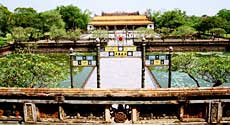Nearly 50 international organisations have joined hands to promote and preserve the cultural heritage in the central city of Hue, after UNESCO called for their support.
 Poland was one of the first countries to send experts to restore The To Mieu (Dynastic Temple) and Ta Vu Pavilion, which was used for administrative functions and festivals, and sponsored the project with US$940,000.
Poland was one of the first countries to send experts to restore The To Mieu (Dynastic Temple) and Ta Vu Pavilion, which was used for administrative functions and festivals, and sponsored the project with US$940,000.
The Japan Trust Fund has financed US$100,000 for the restoration of the Ngo Mon (Noon Gate) and US$250,000 to preserve Nha Nhac, the unique Hue Royal Court Music.
Other organisations from Germany and the Republic of Korea have also supported various restoration projects, including the interior of Khai Tuong Lau-An Dinh Palace, parts of King Tu Duc's Tomb, Toi Linh Tu (Highest Celestial) Temple, the Phu Noi Vu (Royal Treasury), the Imperial City and the Ta Vu.
The National Center for Korean Traditional Performing Arts presented the Center for the Preservation of Hue Relics (CPHR) a bien chung (set of 12 small bronze bells) and bien khanh (sets of 12 small musical stones), which were used in the Hue Royal Court during the Le Dynasty (1427-1788) and Nguyen Dynasty (1802-1945).
CPHR Director Phan Thanh Hai said the centre will continue working closely this year with its traditional partners such as the Republic of Korea, Japan, Germany, the US, Poland and Luxembourg, to further restore Hue's tangible and intangible cultural heritage.
By the end of this year, the CPHR aims to complete the first phase of the restoration of King Dong Khanh's Tomb, as well as, Ta Tung Tu (King Minh Mang's Tomb) and the Thai Binh Lau Palace.
It will continue to invest in other relics and submit its research on the Nguyen dynasty cuisine and literature related to these Hue sites to UNESCO for World Memorial Heritage recognition in the 2012-2013 period.